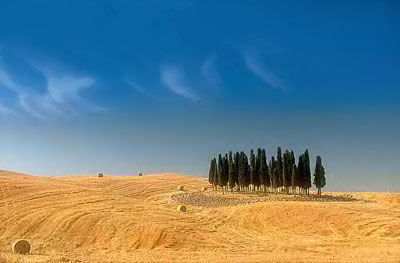CYPRESS TREES (Cupressus sempervirens)
Few people can imagine an Italian garden, without images of tall, needle-like cypress trees springing to mind, so strong is the image of the cypress tree in Italy. The cypress tree’s name would suggest that it didn’t originate in Italy – even though its image really does symbolise Italy and everything that’s Italian about this wonderful land!
The Cypress tree’s origins are just as mysterious as it’s early uses and the folklore surrounding it! It is thought to be a native of the ancient Mesopotamia region between the Tiber and Euphrates rivers, which covered the area of modern day Iraq and Iran (once known as Persia). This area that was covered with Mediterranean forests was also the original home of the magical cypress tree. The same area, namely Persia, was also home to the ancient and equally mysterious Etruscan civilisation that inhabited Tuscany many years before Christ. The Etruscans regarded the cypress tree to be extremely sacred and it is widely believed that it was indeed the Etruscans that originally brought the cypress tree with them when the they began arriving in Tuscany.
The evergreen cypress tree grows to height of 20 to 25m and can survive for many thousands of years, outliving many generations of humans. The cypress tree’s longevity, the fact that it remained evergreen throughout the harsh winters and it’s heady resinous scent earned the plant a divine and spiritual status in Etruscan society. The Etruscans used the plant to line the entrances to their dwellings and they seem to have planted as many cypress’ as possible near to their settlements as they believed the fresh, resinous scent purified the air. On hot days one can detect the scent of a group of cypress trees from many metres away and it’s easy to understand why the Etruscans believed the tree improved the atmosphere with its fresh scent.
The wood of the cypress tree is very long lasting owing to its thick, resinous sap, which protects the wood from insect attack. In fact, the timber also emits a strong yet pleasant scent for many years and the Etruscans used the wood of the cypress tree to create sarcophagi and also in the cremation ceremonies themselves, so special was this plant to these early people.
In the Italian garden the cypress tree offers garden designers like me a tree that provides a vertical visual statement that really no other tree can provide. The evergreen, symbolic shape of this tree, standing s20m tall, appears to stretch skywards rather like the steeple of church and one could be forgiven for perceiving strong, spiritual connotations regarding the shape of this tree alone. Standing in the middle of a group of fully grown cypress trees and looking at the sky is most definitely a spiritual experience, as a strong link can be felt between the land on which one stands and abyss of the blue sky above.
Garden designers in Italy still use the cypress tree to line entrance driveways and create evergreen structure around the house and their presence clearly evokes strong symbolic sentiments. I find them indispensible for framing the stunning views that can be seen from many Italian gardens or as visual indications to guide the eye around my garden designs. The use of the cypress tree in Italian garden design is fundamental, however, care should be taken to not exaggerate the use of this immensely special, symbolic yet very subtle tree in Italian style gardens.
Leslie Halloran
Please check out my website at: www.lihdesigns.net
“A frog in the well does not know the sea.”- Japanese Proverb

0 Comments